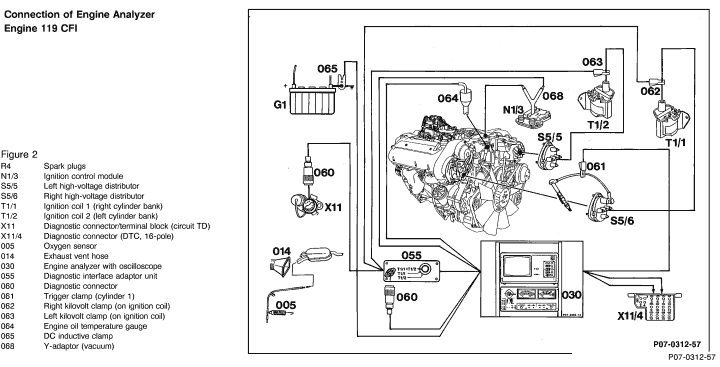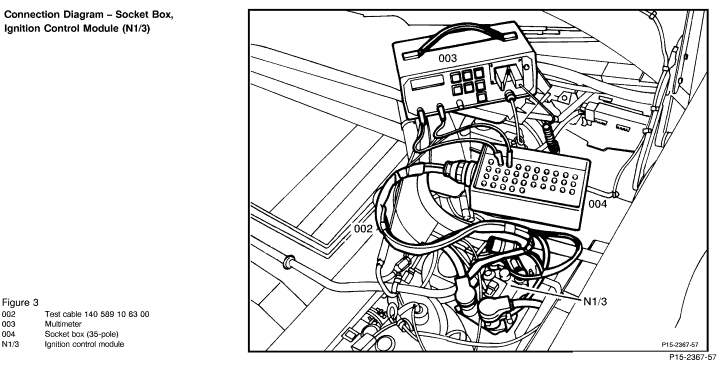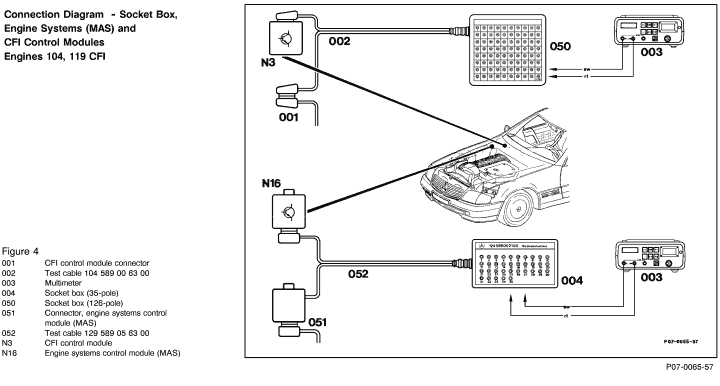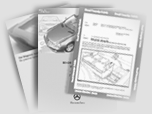|
1. Ignition: OFF
2. Connect socket box to ignition control module (N1/3) with test cable set according to connection diagram.
Electric wiring diagrams, see Electrical Troubleshooting Manual. |
Equipment
| Digital multimeter 1) |
Sun DMM-5
Fluke model 23 with 80i-410 current probe |
| Engine analyzer 1) |
Bear DACE (Model 40-960)
Sun EMT-1019/Master 3
Sun MCM-2110
Sun MEA-1500MB |
| Diagnostic interface adaptor unit 1) |
SUN, Bear |
| 1) Available through the MBUSA Standard Equipment Program. |
Note:
 The sequence and respective values for test conditions of the "Ignition Timing Test" and "Diagnostic Trouble Code (DTC) Readout" must be observed. The sequence and respective values for test conditions of the "Ignition Timing Test" and "Diagnostic Trouble Code (DTC) Readout" must be observed.
 Within a test step, if, for example, the value for point 1 is ok, then proceed to point 2. If the value is not ok, you must then proceed to point 1.1. Within a test step, if, for example, the value for point 1 is ok, then proceed to point 2. If the value is not ok, you must then proceed to point 1.1.
A. Ignition Timing Test
1. Engine at operating temperature (70 - 90 °C). To avoid a false reading, simulate 320  (80 °C engine coolant temperature) with the resistance substitution unit. (Simulate at both sets of sockets of connector for engine coolant temperature sensor B11/2 to prevent CFI control module from reading a temperature deviation and storing this as a malfunction). (80 °C engine coolant temperature) with the resistance substitution unit. (Simulate at both sets of sockets of connector for engine coolant temperature sensor B11/2 to prevent CFI control module from reading a temperature deviation and storing this as a malfunction).
2. Run engine for at least 8 seconds at 3100 - 3600 rpm with vacuum line connected.
3. Disconnect vacuum line with engine at idle.
4. Run engine for at least 2 seconds above 3100 rpm.
5. Record firing point at idle without vacuum.
6. Reconnect vacuum line and record firing point.
 Important Note! Important Note!
 Do not turn the engine off during this test procedure. Do not turn the engine off during this test procedure.
Engine 119:
 During the entire test, the engine analyzer must be set to "4 cylinder". During the entire test, the engine analyzer must be set to "4 cylinder".
 During diagnosis, e.g. evaluation of oscilloscope screen, power balance test, etc., the diagnostic interface adaptor unit must be switched between the engine analyzer and diagnostic connector (see connection diagram), as otherwise false readouts may occur. During diagnosis, e.g. evaluation of oscilloscope screen, power balance test, etc., the diagnostic interface adaptor unit must be switched between the engine analyzer and diagnostic connector (see connection diagram), as otherwise false readouts may occur.
 The ignition timing test can be performed with or without the diagnostic interface adaptor unit, whereby the engine analyzer must be set to The ignition timing test can be performed with or without the diagnostic interface adaptor unit, whereby the engine analyzer must be set to
"4 cylinder". |
B. To Avoid Damage to the Ignition System
 To avoid damage to the ignition control module (N1/3), connect/disconnect the control module connectors only when the ignition is turned off. To avoid damage to the ignition control module (N1/3), connect/disconnect the control module connectors only when the ignition is turned off.
 Do not connect a test lamp to circuit 1 of the ignition coil. Do not connect a test lamp to circuit 1 of the ignition coil.
 Circuits 1 and 15 of the ignition coil may not be shorted to ground, e. g. theft deterrence. Circuits 1 and 15 of the ignition coil may not be shorted to ground, e. g. theft deterrence.
 To avoid reversing polarity, the threads on the ignition coil have different diameters (M5 and M6). To avoid reversing polarity, the threads on the ignition coil have different diameters (M5 and M6).
 Only original equipment components should be installed in the ignition system. Only original equipment components should be installed in the ignition system.
 Do not operate the ignition system at cranking speed unless the ignition harness is completely connected. Do not operate the ignition system at cranking speed unless the ignition harness is completely connected.
 To avoid damage to the ignition control module (N1/3), the high output side of the ignition system must carry at least 2 k To avoid damage to the ignition control module (N1/3), the high output side of the ignition system must carry at least 2 k  of load (distributor rotor 1 k of load (distributor rotor 1 k  , each connection on the distributor cap 1 k , each connection on the distributor cap 1 k  ). Do not install a 5 k ). Do not install a 5 k  distributor rotor for noise suppression. distributor rotor for noise suppression.
 Do not perform any tests (grounding ignition cable 4, disconnecting a spark plug connector or pulling cable 4 out of the ignition coil) at cranking or idle speed. Do not perform any tests (grounding ignition cable 4, disconnecting a spark plug connector or pulling cable 4 out of the ignition coil) at cranking or idle speed.
 To better dissipate heat, the ignition control module (N1/3) is installed with thermal paste on the wheel well. When exchanging the control module, do not remove the foil shield, it does not influence heat dissipation. To better dissipate heat, the ignition control module (N1/3) is installed with thermal paste on the wheel well. When exchanging the control module, do not remove the foil shield, it does not influence heat dissipation.
 If the circuit breaker is activated (power balance test), and the engine stalls, then the test procedure with this tester cannot be performed. If the circuit breaker is activated (power balance test), and the engine stalls, then the test procedure with this tester cannot be performed.
 When testing the ignition coil separately, do not load the coil with more than 28 kV in order to avoid damage to the coil. When testing the ignition coil separately, do not load the coil with more than 28 kV in order to avoid damage to the coil.
 If assisting a disabled vehicle and it becomes necessary to perform an ignition spark test, perform this test only on one ignition cable/spark plug. Ensure good ground connection to the spark plug. If assisting a disabled vehicle and it becomes necessary to perform an ignition spark test, perform this test only on one ignition cable/spark plug. Ensure good ground connection to the spark plug.
 WARNING! WARNING!
High Voltage!
C. Using Test Equipment
 Ensure that the engine and ignition are turned off when connecting/ disconnecting equipment such as voltage signal pick-up on ignition cable 4 and trigger pick-up on cylinder 1. Ensure that the engine and ignition are turned off when connecting/ disconnecting equipment such as voltage signal pick-up on ignition cable 4 and trigger pick-up on cylinder 1. |
 |
 |
 |
 |
|


 Printable version
Printable version


 Printable version
Printable version